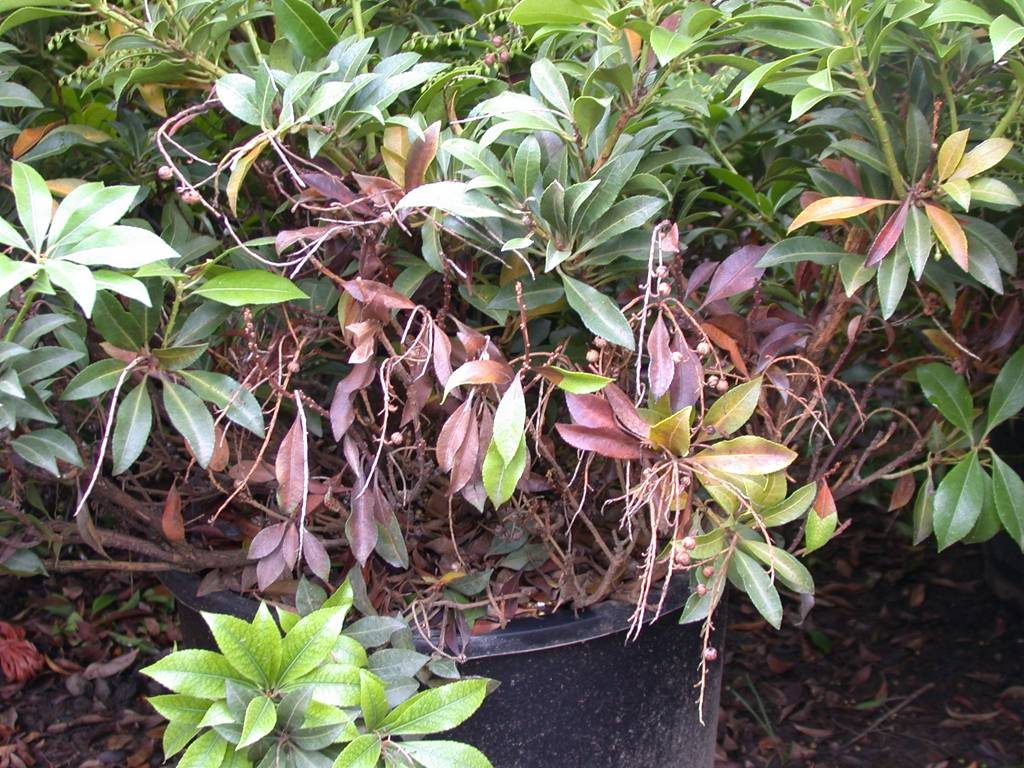
photo by Jennifer Parke, Oregon State University
It might be déjà vu all over again.
Fifteen years ago, in the spring of 2004, officials discovered that the disease called “sudden oak death” or “ramorum blight” was present on camellias at a large California nursery that shipped $30 million worth of plants interstate on an annual basis. The nursery was in southern California, far from the wetter areas of northern California where the disease is established in the wild and where regulatory efforts were focused. By the end of 2004, 176 nurseries in 21 states had received infected plants, 125 of which were linked to the California supplier. APHIS and the affected states and nurseries had to spend millions to find and destroy infected plants and conduct intensive surveys to try to ensure this situation was not repeated.
APHIS had begun regulating P. ramorum in nurseries in northern California and Oregon in February 2002. These regulations went through several rounds of change after the 2004 outbreak – discussed in Chapter 5 of Fading Forests III, available here.
Beginning in 2014, APHIS issued two Federal orders that relaxed some of the regulatory requirements for nurseries.
Just this past May, APHIS completed the process of integrating these changes into its formal regulations. (See my blog from May and the text of the new regulations here.) APHIS stated in replying to comments on the rulemaking that it was confident that the new regime provided sufficient protection.
Even as APHIS was finalizing this rule change, Indiana officials discovered that rhododendron plants imported into the state were infected with Phytophthora ramorum!!
Indiana authorities reported that potentially infested plants were received at more than 70 WalMart stores and 18 Rural King stores. By the end of May, state inspectors have destroyed more than 1,500 rhododendrons and have put another 1,500 other plants on hold [source: Indianapolis Star website 29 May, 2019]
Indiana authorities also said that the same source nurseries had shipped plants to nine other states – unnamed.
In mid-June – more than a month after Indiana’s initial detection [Indianapolis Star website 23 May] – APHIS issued a statement. In an email to me, Evelia Sosa, Assistant Director of Pest Management, reported that potentially infested plants from the original suppliers were sent to 18 states! These states are Alabama, Arkansas, Iowa, Illinois, Indiana, Kansas, Kentucky, Michigan, Missouri, Nebraska, North Carolina, Ohio, Oklahoma, Pennsylvania, Tennessee, Texas, Virginia, and West Virginia. State officials Agriculture officials in these States are currently visiting nursery locations to sample plants received from the originating nurseries. Plants that test positive for P. ramorum will be destroyed. All plants that are within a 2 meter radius of an infected plant will also be destroyed. Host plants outside the 2 meter radius will be sampled intensively. Other hosts in the impacted facilities will be monitored for signs of the disease.
Homeowners who might have purchased infected plants are advised by APHIS to monitor them carefully for symptoms; a website is provided — ironically (see below), it is the website of the California Oak Mortality Task Force!
Several of the states which received potentially infected plants have already been through this routine because infected plants were shipped to their nurseries in the 2004 – 2008 period. These include Alabama, North Carolina, and Texas. P. ramorum has been found multiple times in streams or ponds associated with the receiving nurseries (see my blog from May here)
There are several reasons for particular concern. First, the source nurseries were in Washington State and British Columbia. How did the inspection system fail to detect the outbreaks before the plants were shipped? Inspections now include testing of soil and standing water, not just visual inspection of plants. Second, at least some of the infected plants are rhododendrons – which are taxa well known to be vulnerable to the pathogen and the specified focus of detection efforts!
This would seem to verify concerns raised in its comments on the proposal (see the above website) by the California Oak Mortality Task Force, whose members have been studying and managing the outbreak for close to twenty years. COMTF said:
“The revised framework, in many ways, matches the rule structure present in 2004, when the pathogen was inadvertently, potentially shipped to over 1,200 nurseries in 39 states from a few nurseries in Southern California, Oregon and Washington. At that time, the APHIS P. ramorum regulation restricted shipments in the quarantine area, defined as the known infested counties in California and part of Curry Co., Oregon; however, the source nurseries were located in counties where P. ramorum was not present in wildlands. This revised framework does not adequately protect against the reality, that any nursery with host plants, anywhere, is a potential source for infested plants
How is APHIS going to respond – not just in leading efforts to detect and destroy infected plants but also to review its regulatory program? Why did APHIS wait so long to inform me – and presumably others in the public – about this most recent outbreak. (Although as of the time of posting, APHIS had not issued an announcement to the people registered on its stakeholder registry.)
It is not a surprise that APHIS is backing away from regulations. As I document in my blog here, the agency began some years ago to stress collaborative approaches rather than regulations. But there are risks and costs associated with these decisions.
There are troubling situations applying to other forest pests that I hope to blog about soon.
Posted by Faith Campbell
We welcome comments that supplement or correct factual information, suggest new approaches, or promote thoughtful consideration. We post comments that disagree with us — but not those we judge to be not civil or inflammatory.